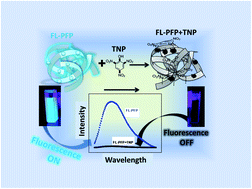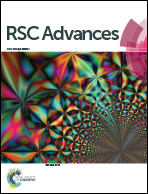A porous β-cyclodextrin-based terpolymer fluorescence sensor for in situ trinitrophenol detection†
Abstract
Permanent porosity plays a key role in fluorescent-based polymers with “on–off” emissive properties due to the role of guest adsorption at accessible fluorophore sites of the polymer framework. In particular, we report on the design of a porous fluorescent polymer (FL-PFP) composed of a covalently cross-linked ternary combination of β-cyclodextrin (β-CD), 4,4′-diisocyanato-3,3′-dimethyl biphenyl (DL) and tetrakis(4-hydoxyphenyl)ethene (TPE). The textural properties of FL-PFP were evaluated by the gas uptake properties using N2 and CO2 isotherms. The BET surface area estimates according to N2 uptake ranged from 100–150 m2 g−1, while a lower range of values (20–30 m2 g−1) was estimated for CO2 uptake. Model nitroarenes such as trinitrophenol (TNP) and nitrobenzene (NB) were shown to induce turn-off of the fluorescence emission of the polymer framework at concentrations near 50 nM with ca. 50% fluorescence quenching upon TNP adsorption and detection. The strong donor–acceptor interaction between the nitroarenes and the TPE reporter unit led to fluorescence quenching of FL-PFP upon nitroarene adsorption. The fluorescence lifetime (τ) for FL-PFP (τ = 3.82 ns) was obtained along with a quantum yield estimate of 0.399 relative to quinine sulphate. The β-CD terpolymer reported herein has significant potential for monitoring the rapid and controlled detection of nitroarenes (TNP and NB) in aquatic environments and other complex media.

- This article is part of the themed collection: Editors’ collection: Fluorescent Sensors


 Please wait while we load your content...
Please wait while we load your content...